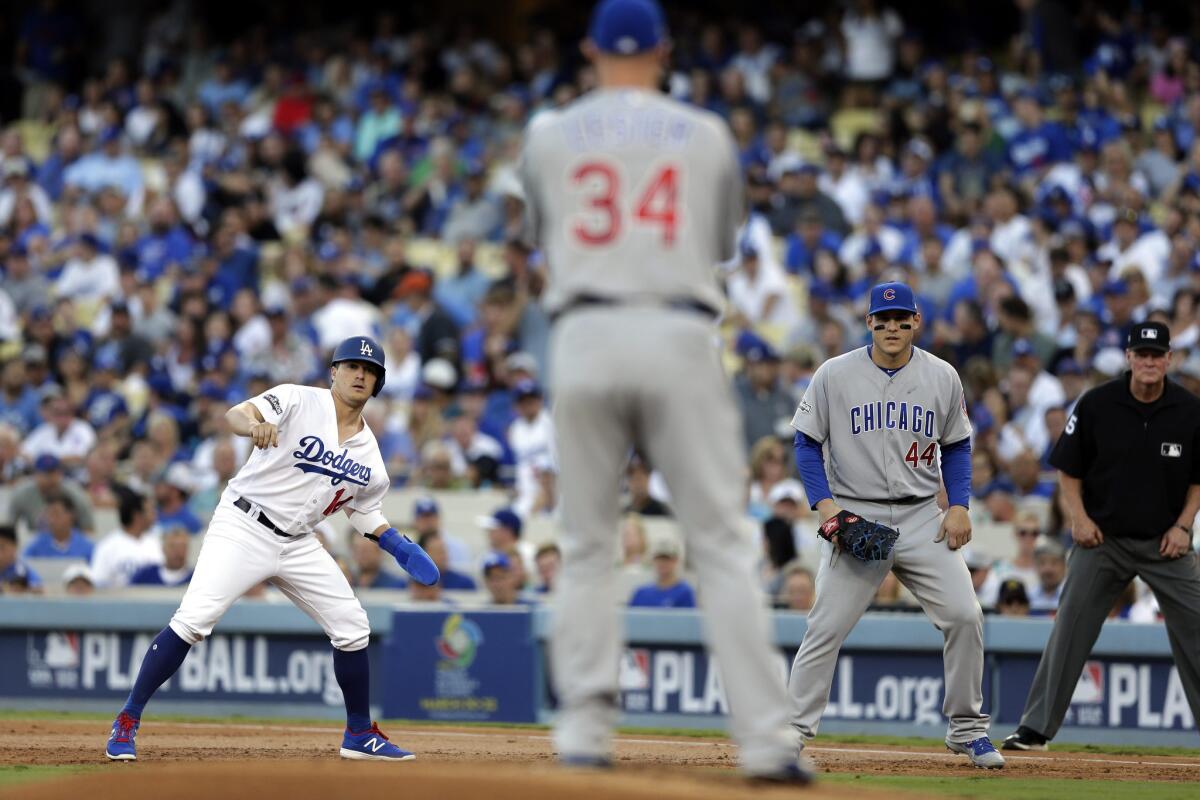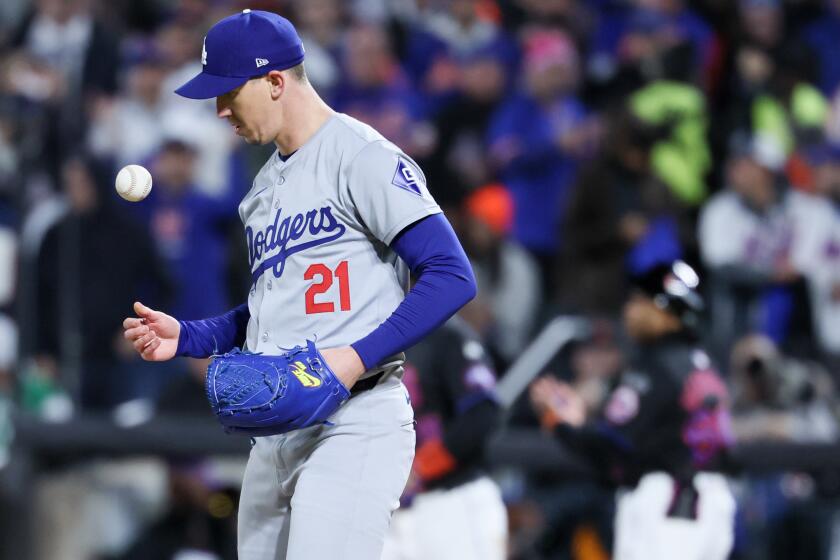The puzzle of Cubs ace Jon Lester: He’s hard to hit but easy to run on

Dodgers baserunner Enrique Hernandez, left, takes his lead off first base as Cubs starting pitcher Jon Lester (34) and first baseman Anthony Rizzo (44) keep an eye on him in the first inning of NLCS Game 5.
Reporting from Cleveland — On Thursday in a suburb of Kansas City, a 61-year-old baseball lifer named Rusty Kuntz sank into his couch and turned on his television. The Dodgers were about to face Chicago Cubs starter Jon Lester in the National League Championship Series, and Kuntz was curious to see if another team could exploit his handiwork.
Two years ago in the American League wild-card game, in his role as the Royals’ first-base coach, Kuntz uncovered one of the sport’s oddities, an issue which could play a critical role in Game 1 of the World Series between the Cubs and the Cleveland Indians on Tuesday at Progressive Field: Lester cannot throw the baseball to first base.
Lester does not run from his weakness. The greater curiosity is why teams do not run on him.
In their Game 5 loss, the Dodgers did steal two bases against Lester. But mostly, Kuntz noticed how runners like Enrique Hernandez behaved in the first inning, taking sizable leads, hopping around, attempting to goad Lester into discomfort. Except when Lester delivered the ball to the plate, the runners were unwilling to gamble on the contents of the team’s scouting report.
“Everybody says ‘You’ve got to run. He’s not going to throw over there,’” Kuntz said. “It’s easier said than done, because all the players are going, ‘There’s got to be a trap in here somewhere. My gosh, there’s no way that a big league pitcher can’t at least throw it around the bag.’”
The behavior of the Dodgers showed the paradox of Lester’s situation. Everyone in baseball knows about it. But no one seems to believe it’s real.
The 112th World Series overflows with story lines. The Cubs have not won a championship since 1908; Cleveland has gone without since 1948. Cleveland Manager Terry Francona competes against a club assembled by Cubs architect Theo Epstein, reuniting the duo that ended Boston’s 86-year championship drought in 2004. After starting the season as New York Yankees teammates, relief aces Aroldis Chapman of the Cubs and Andrew Miller of the Indians will vie for bullpen supremacy.
But the most intriguing subplot involves Lester hoping to contain opposing runners. His issues are not limited to pickoff attempts. In the field, his throws veer in unexpected directions. He bounced the ball to first base after fielding a bunt in Game 5. On another occasion this season, he threw his entire glove.
Unlike the Dodgers, cursed with leaden feet, the Indians led the American League in stolen bases and baserunning efficiency, according to FanGraphs.
“Everybody’s game plan is to try to disrupt him as much as possible, because he’s one of the best pitchers in the game,” said Cleveland outfielder Coco Crisp, who played with Lester in Boston and Oakland. “But how we’re going to go about that, I can’t quite tell you.”
Lester, 32, had his best season in 2016, going 19-5 with a 2.44 earned-run average. And he thrives in October, with a playoff resume featuring 17 starts and a 2.50 ERA, including 2-0 and 0.86 in three starts this fall. As a 23-year-old in 2007, less than a year after he’d beaten lymphoma, Lester earned the victory for Boston in the deciding game of the World Series.
Yet his gift for navigating the strike zone with precision and efficiency, combined with an unflappable demeanor, could not prevent him from succumbing to a mystifying loss of the ability to throw the baseball to first. The colloquial version of this condition is called the “yips,” but some players use a more ominous name: The Thing.
In the 1970s, Pittsburgh pitcher Steve Blass stopped throwing strikes. In the 1980s, Dodgers second baseman Steve Sax struggled to relay the ball to fellow infielders after fielding grounders. In the 1990s, Mets catcher Mackey Sasser couldn’t return the baseball to the pitcher.
And near the end of his tenure as Red Sox manager, Francona noticed Lester developing similarly perplexing tendencies. The concept sounds simple — just throw the ball! — but for Lester it became a chore.
“We knew it was surfacing, and we did a lot of things to make sure it didn’t get out in the open,” Francona said. “And I thought we actually did a really good job, because it wasn’t until I left [that] people started to realize that.”
In 2011, Francona’s final season in Boston, Lester made 70 throws to first base. That number fell to five in 2012 and seven in 2013. During the 2014 regular season, he did not attempt a single pickoff. Traded to Oakland midway through 2014, he soon would see his secret revealed against Kansas City.
The Royals felt their bats alone could not wound Lester. They needed to activate their legs, and Kuntz urged them to take outrageous leads and steal bases with impunity. After a few innings of uncertainty, the players swiped three bases off him and charged him for six runs in a comeback victory.
The game exposed Lester. But it did not hurt his market as a free agent that winter. The Cubs signed him to a $155-million contract. No pitcher allowed more stolen bases than Lester in 2015, but he tightened deficiencies this season.
“All pitchers do certain things well, and certain things not so well,” Cubs pitching coach Chris Bosio said. “They’re not robots.”
Exploiting Lester is not easy. The primary problem is hitters cannot steal first base, and he posted a 1.016 WHIP (walks plus hits per inning pitched) in 2016. When batters do reach, Lester has developed a series of feints.
Lester relies on his fastball, and his delivery is swift. He alters his tempo to avoid patterns, and he steps off the mound, “although he’ll just hold the ball and look at you,” Kuntz said. In addition, veteran catcher David Ross often throws back to first base after receiving the ball.
Lastly, Lester also benefits from the hesitation of his opponents. Like Kuntz, Indians outfielder Rajai Davis was surprised by the Dodgers’ approach in Game 5. He saw how far the runners drifted from the bases.
“I noticed nobody was running, either,” said Davis, who stole 43 bases this season. “It defeated the purpose, I think.”
For Davis, the discussion of Lester’s issues sounded “like music to my ears.” But the challenge will not be answered with words. Actions mean more.
“You’ve got to get past the fear of being embarrassed,” Kuntz said. “You always have that in the back of your mind. You really don’t know how to attack something that you hardly ever see.”
Twitter: @McCulloughTimes
More to Read
Go beyond the scoreboard
Get the latest on L.A.'s teams in the daily Sports Report newsletter.
You may occasionally receive promotional content from the Los Angeles Times.










